In-Depth Analysis of Honda's Business Operations and Reliability
VerifiedAdded on 2023/06/12
|22
|4108
|93
Report
AI Summary
This report provides a comprehensive analysis of Honda Motor Co. Ltd.'s business operations and reliability strategies. It begins with a company description, highlighting Honda's mission, key performance indicators (KPIs), and operational philosophies. The report includes a flowchart illustrating the interrelation of various manufacturing and processing functions, followed by an affinity diagram identifying key factors such as customer satisfaction and efficient manufacturing. A detailed table outlines consumer requirements ('Whats') and the required processes ('Hows'), which are then used to construct a House of Quality (HOQ) for Honda's processes. The report also covers Honda's information collection system, emphasizing market analysis and social media-based research. It concludes with performance importance graph and recommendations for improving Honda's operational efficiency and reliability. Desklib provides access to similar solved assignments and study tools for students.
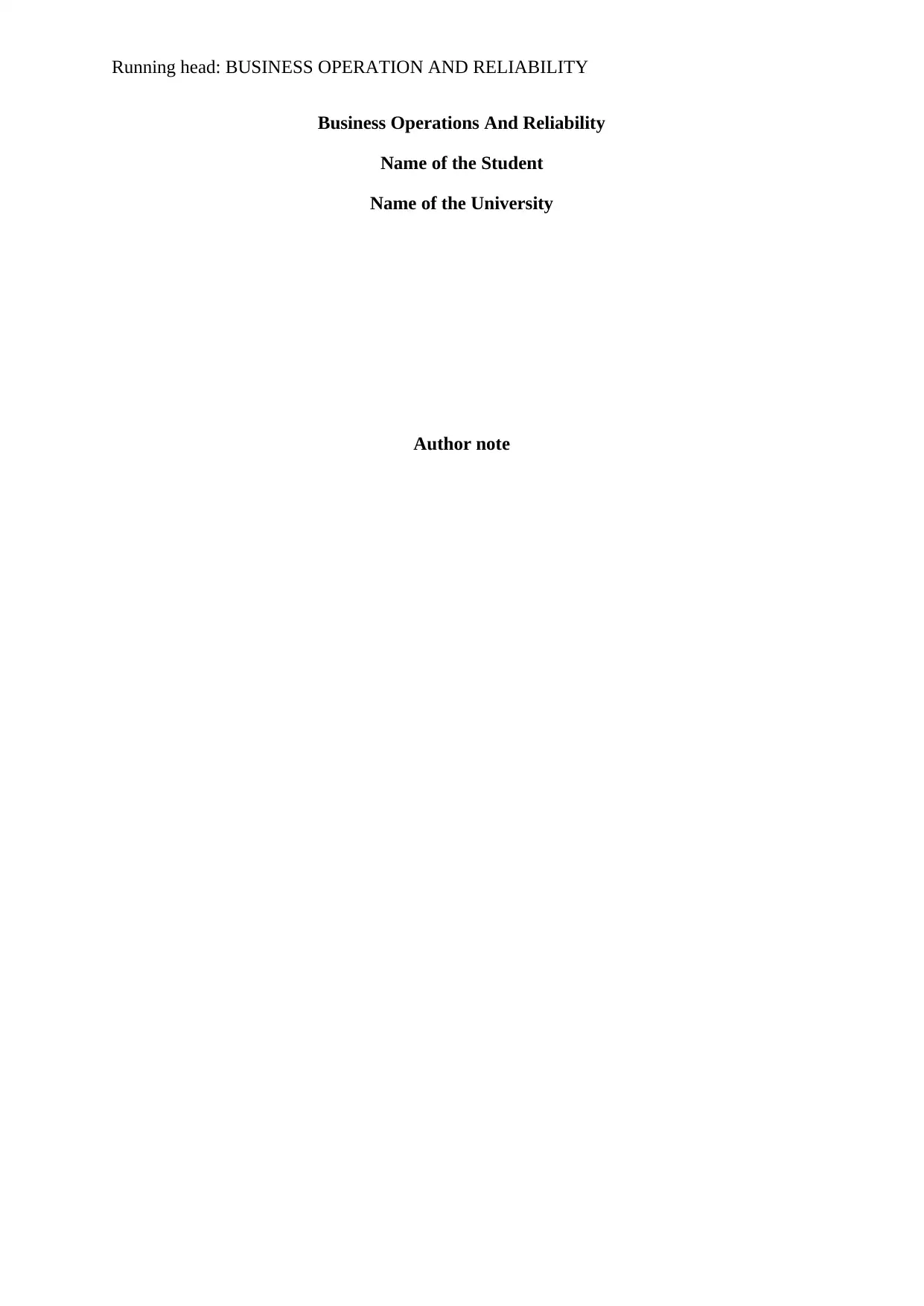
Running head: BUSINESS OPERATION AND RELIABILITY
Business Operations And Reliability
Name of the Student
Name of the University
Author note
Business Operations And Reliability
Name of the Student
Name of the University
Author note
Paraphrase This Document
Need a fresh take? Get an instant paraphrase of this document with our AI Paraphraser
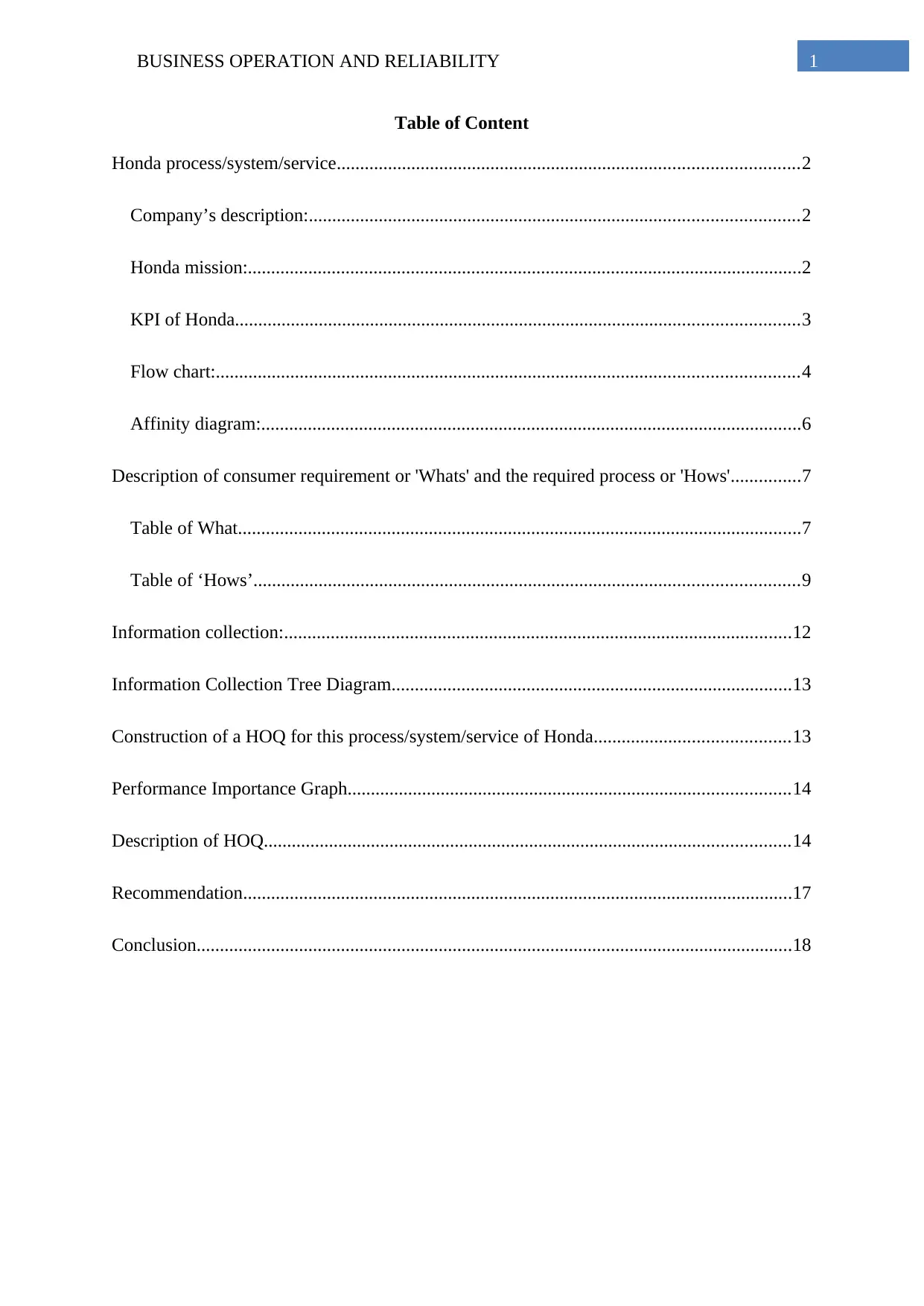
1BUSINESS OPERATION AND RELIABILITY
Table of Content
Honda process/system/service...................................................................................................2
Company’s description:.........................................................................................................2
Honda mission:.......................................................................................................................2
KPI of Honda.........................................................................................................................3
Flow chart:.............................................................................................................................4
Affinity diagram:....................................................................................................................6
Description of consumer requirement or 'Whats' and the required process or 'Hows'...............7
Table of What.........................................................................................................................7
Table of ‘Hows’.....................................................................................................................9
Information collection:.............................................................................................................12
Information Collection Tree Diagram......................................................................................13
Construction of a HOQ for this process/system/service of Honda..........................................13
Performance Importance Graph...............................................................................................14
Description of HOQ.................................................................................................................14
Recommendation......................................................................................................................17
Conclusion................................................................................................................................18
Table of Content
Honda process/system/service...................................................................................................2
Company’s description:.........................................................................................................2
Honda mission:.......................................................................................................................2
KPI of Honda.........................................................................................................................3
Flow chart:.............................................................................................................................4
Affinity diagram:....................................................................................................................6
Description of consumer requirement or 'Whats' and the required process or 'Hows'...............7
Table of What.........................................................................................................................7
Table of ‘Hows’.....................................................................................................................9
Information collection:.............................................................................................................12
Information Collection Tree Diagram......................................................................................13
Construction of a HOQ for this process/system/service of Honda..........................................13
Performance Importance Graph...............................................................................................14
Description of HOQ.................................................................................................................14
Recommendation......................................................................................................................17
Conclusion................................................................................................................................18
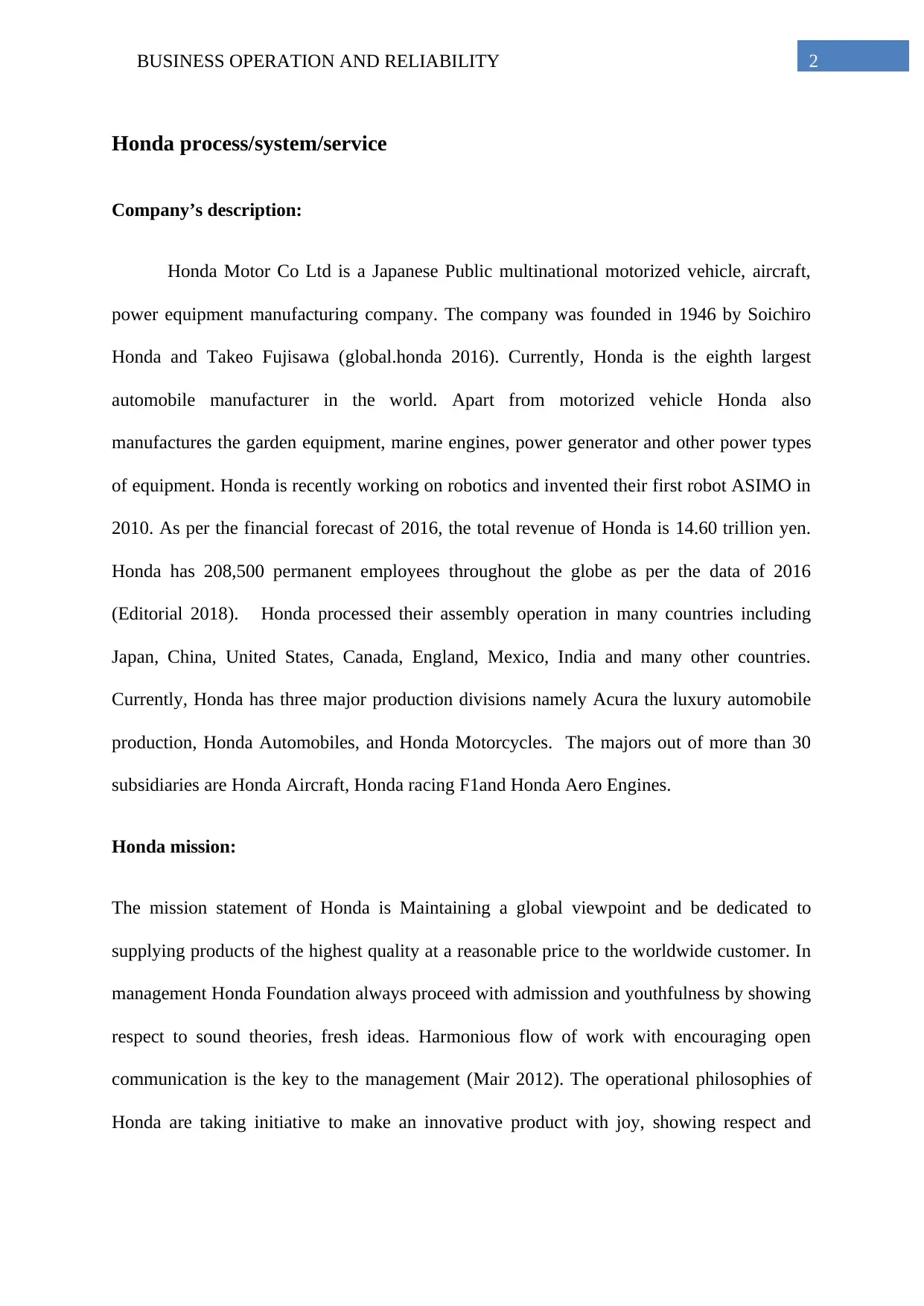
2BUSINESS OPERATION AND RELIABILITY
Honda process/system/service
Company’s description:
Honda Motor Co Ltd is a Japanese Public multinational motorized vehicle, aircraft,
power equipment manufacturing company. The company was founded in 1946 by Soichiro
Honda and Takeo Fujisawa (global.honda 2016). Currently, Honda is the eighth largest
automobile manufacturer in the world. Apart from motorized vehicle Honda also
manufactures the garden equipment, marine engines, power generator and other power types
of equipment. Honda is recently working on robotics and invented their first robot ASIMO in
2010. As per the financial forecast of 2016, the total revenue of Honda is 14.60 trillion yen.
Honda has 208,500 permanent employees throughout the globe as per the data of 2016
(Editorial 2018). Honda processed their assembly operation in many countries including
Japan, China, United States, Canada, England, Mexico, India and many other countries.
Currently, Honda has three major production divisions namely Acura the luxury automobile
production, Honda Automobiles, and Honda Motorcycles. The majors out of more than 30
subsidiaries are Honda Aircraft, Honda racing F1and Honda Aero Engines.
Honda mission:
The mission statement of Honda is Maintaining a global viewpoint and be dedicated to
supplying products of the highest quality at a reasonable price to the worldwide customer. In
management Honda Foundation always proceed with admission and youthfulness by showing
respect to sound theories, fresh ideas. Harmonious flow of work with encouraging open
communication is the key to the management (Mair 2012). The operational philosophies of
Honda are taking initiative to make an innovative product with joy, showing respect and
Honda process/system/service
Company’s description:
Honda Motor Co Ltd is a Japanese Public multinational motorized vehicle, aircraft,
power equipment manufacturing company. The company was founded in 1946 by Soichiro
Honda and Takeo Fujisawa (global.honda 2016). Currently, Honda is the eighth largest
automobile manufacturer in the world. Apart from motorized vehicle Honda also
manufactures the garden equipment, marine engines, power generator and other power types
of equipment. Honda is recently working on robotics and invented their first robot ASIMO in
2010. As per the financial forecast of 2016, the total revenue of Honda is 14.60 trillion yen.
Honda has 208,500 permanent employees throughout the globe as per the data of 2016
(Editorial 2018). Honda processed their assembly operation in many countries including
Japan, China, United States, Canada, England, Mexico, India and many other countries.
Currently, Honda has three major production divisions namely Acura the luxury automobile
production, Honda Automobiles, and Honda Motorcycles. The majors out of more than 30
subsidiaries are Honda Aircraft, Honda racing F1and Honda Aero Engines.
Honda mission:
The mission statement of Honda is Maintaining a global viewpoint and be dedicated to
supplying products of the highest quality at a reasonable price to the worldwide customer. In
management Honda Foundation always proceed with admission and youthfulness by showing
respect to sound theories, fresh ideas. Harmonious flow of work with encouraging open
communication is the key to the management (Mair 2012). The operational philosophies of
Honda are taking initiative to make an innovative product with joy, showing respect and
⊘ This is a preview!⊘
Do you want full access?
Subscribe today to unlock all pages.

Trusted by 1+ million students worldwide

3BUSINESS OPERATION AND RELIABILITY
equity to individuals and maintaining a strong and sustainable relationship with business
partners, stakeholders, customers and workers.
KPI of Honda
Honda has their specific and measurable Key Performance Indicator (KPI) that helps to
maintain and improve the functionality and operational efficiency of each department (Sutton
2012). However, Honda Management has divided the basic KPI into five major subsections.
Financial Perspective based KPI regulate all the financial efficiency and accountable
component of the company. The operational KPI of this section are:
Sales volume for new product
Revenue from the new products
Manufacturing cost vs. Budget
Marketing and advertising expense
Customer perspective based KPI regulate the marketing, promotion, consumer behaviour and
other related components. These KPI are:
Number of customers
Customer satisfaction
Market share and brand value
Process Perspective based KPIs are formed to assess the functionality of manufacturing and
other related operations like inbound and outbound logistics. These KPI are:
Developing new products
Improving existing product
Decrease material loss
Ensure high standards of product quality
equity to individuals and maintaining a strong and sustainable relationship with business
partners, stakeholders, customers and workers.
KPI of Honda
Honda has their specific and measurable Key Performance Indicator (KPI) that helps to
maintain and improve the functionality and operational efficiency of each department (Sutton
2012). However, Honda Management has divided the basic KPI into five major subsections.
Financial Perspective based KPI regulate all the financial efficiency and accountable
component of the company. The operational KPI of this section are:
Sales volume for new product
Revenue from the new products
Manufacturing cost vs. Budget
Marketing and advertising expense
Customer perspective based KPI regulate the marketing, promotion, consumer behaviour and
other related components. These KPI are:
Number of customers
Customer satisfaction
Market share and brand value
Process Perspective based KPIs are formed to assess the functionality of manufacturing and
other related operations like inbound and outbound logistics. These KPI are:
Developing new products
Improving existing product
Decrease material loss
Ensure high standards of product quality
Paraphrase This Document
Need a fresh take? Get an instant paraphrase of this document with our AI Paraphraser
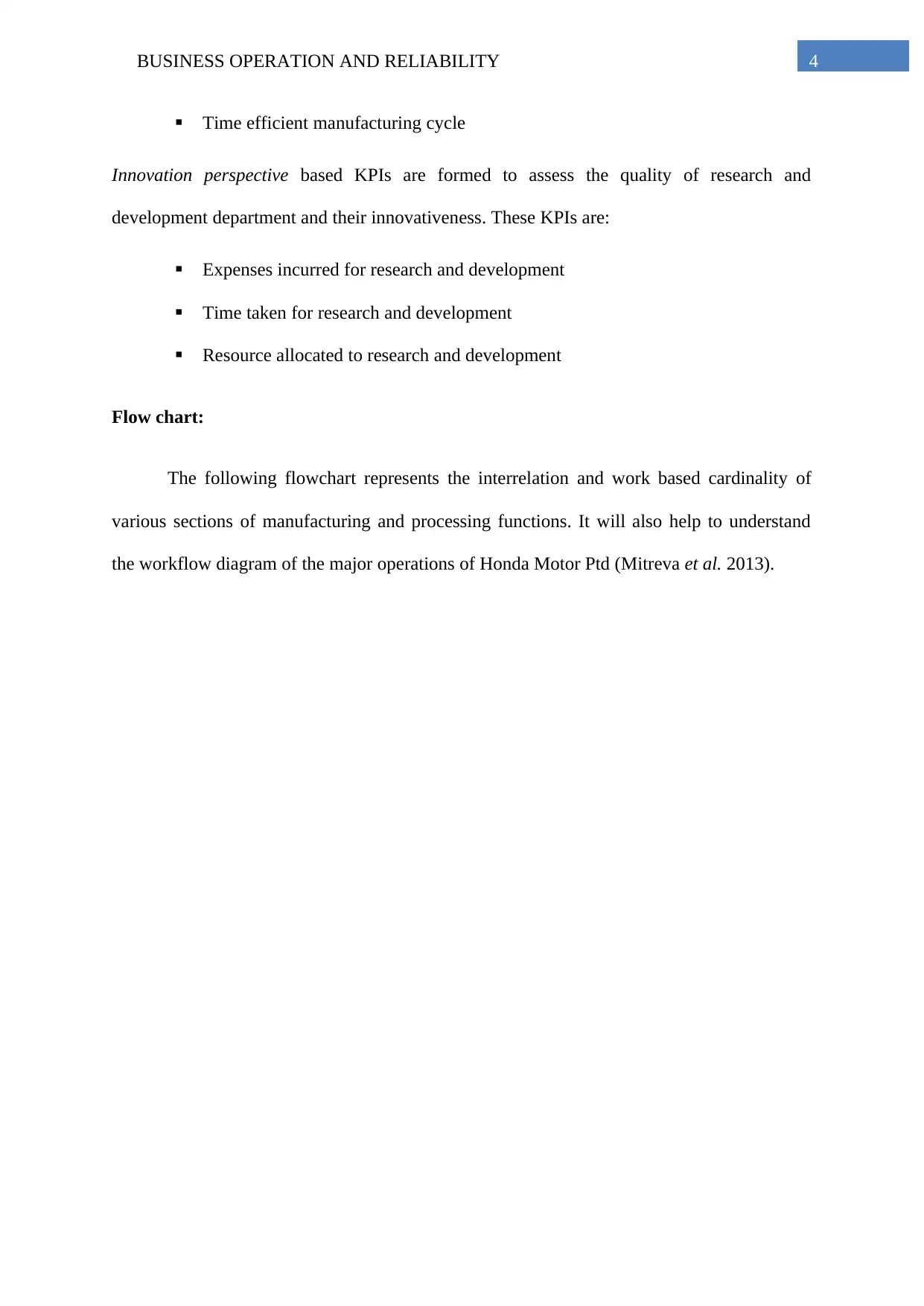
4BUSINESS OPERATION AND RELIABILITY
Time efficient manufacturing cycle
Innovation perspective based KPIs are formed to assess the quality of research and
development department and their innovativeness. These KPIs are:
Expenses incurred for research and development
Time taken for research and development
Resource allocated to research and development
Flow chart:
The following flowchart represents the interrelation and work based cardinality of
various sections of manufacturing and processing functions. It will also help to understand
the workflow diagram of the major operations of Honda Motor Ptd (Mitreva et al. 2013).
Time efficient manufacturing cycle
Innovation perspective based KPIs are formed to assess the quality of research and
development department and their innovativeness. These KPIs are:
Expenses incurred for research and development
Time taken for research and development
Resource allocated to research and development
Flow chart:
The following flowchart represents the interrelation and work based cardinality of
various sections of manufacturing and processing functions. It will also help to understand
the workflow diagram of the major operations of Honda Motor Ptd (Mitreva et al. 2013).
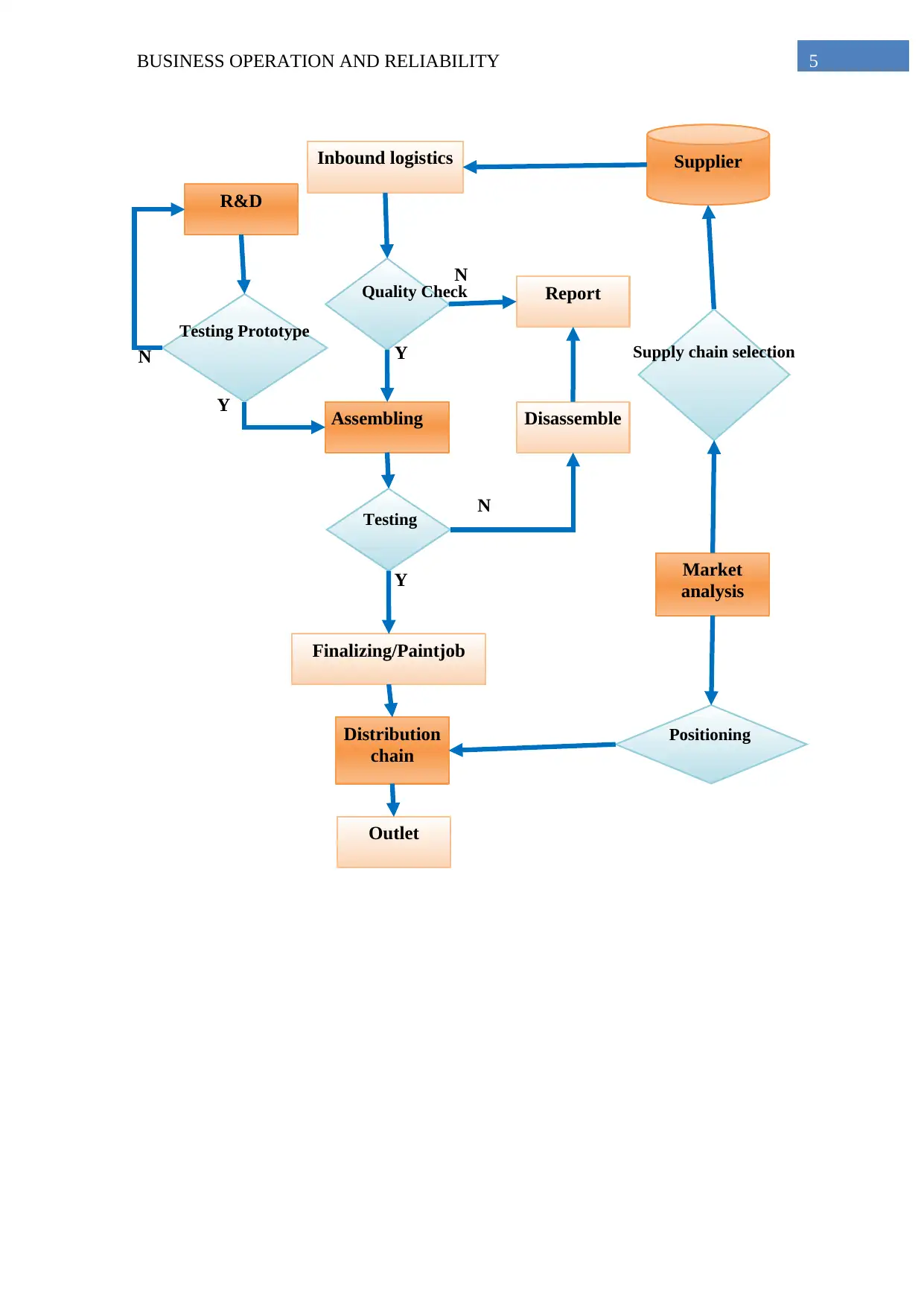
5BUSINESS OPERATION AND RELIABILITY
Inbound logistics
DisassembleAssembling
Finalizing/Paintjob
Distribution
chain
Quality Check Report
Testing
R&D
Testing Prototype
Market
analysis
Positioning
Outlet
Y
Y
N
N
N
Y Supply chain selection
Supplier
Inbound logistics
DisassembleAssembling
Finalizing/Paintjob
Distribution
chain
Quality Check Report
Testing
R&D
Testing Prototype
Market
analysis
Positioning
Outlet
Y
Y
N
N
N
Y Supply chain selection
Supplier
⊘ This is a preview!⊘
Do you want full access?
Subscribe today to unlock all pages.

Trusted by 1+ million students worldwide
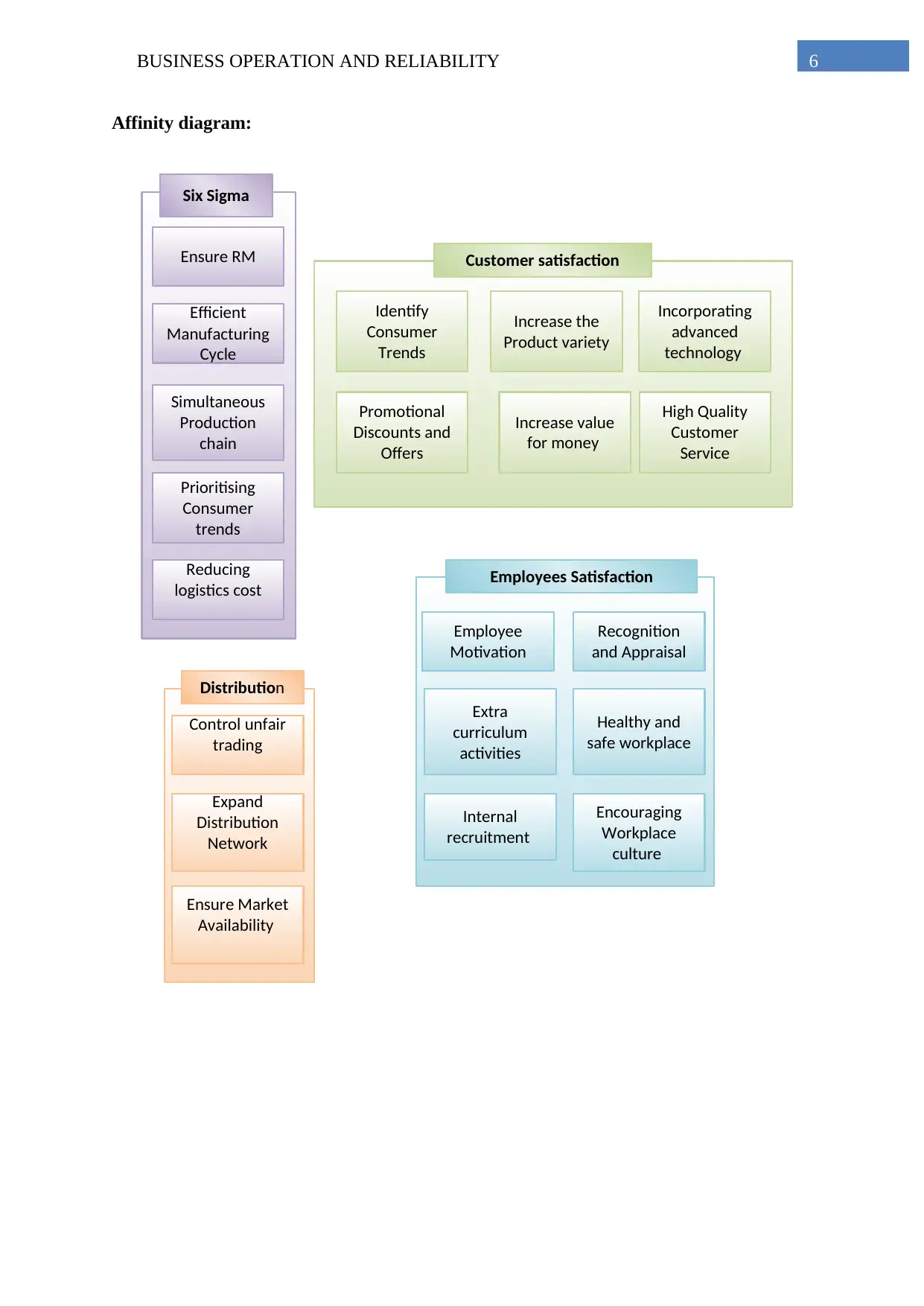
6BUSINESS OPERATION AND RELIABILITY
Ensure RM
Efficient
Manufacturing
Cycle
Reducing
logistics cost
Simultaneous
Production
chain
Six Sigma
Prioritising
Consumer
trends
Identify
Consumer
Trends
Customer satisfaction
Increase the
Product variety
Incorporating
advanced
technology
Promotional
Discounts and
Offers
Increase value
for money
High Quality
Customer
Service
Employee
Motivation
Employees Satisfaction
Extra
curriculum
activities
Recognition
and Appraisal
Internal
recruitment
Healthy and
safe workplace
Encouraging
Workplace
culture
Control unfair
trading
Distribution
Expand
Distribution
Network
Ensure Market
Availability
Affinity diagram:
Ensure RM
Efficient
Manufacturing
Cycle
Reducing
logistics cost
Simultaneous
Production
chain
Six Sigma
Prioritising
Consumer
trends
Identify
Consumer
Trends
Customer satisfaction
Increase the
Product variety
Incorporating
advanced
technology
Promotional
Discounts and
Offers
Increase value
for money
High Quality
Customer
Service
Employee
Motivation
Employees Satisfaction
Extra
curriculum
activities
Recognition
and Appraisal
Internal
recruitment
Healthy and
safe workplace
Encouraging
Workplace
culture
Control unfair
trading
Distribution
Expand
Distribution
Network
Ensure Market
Availability
Affinity diagram:
Paraphrase This Document
Need a fresh take? Get an instant paraphrase of this document with our AI Paraphraser
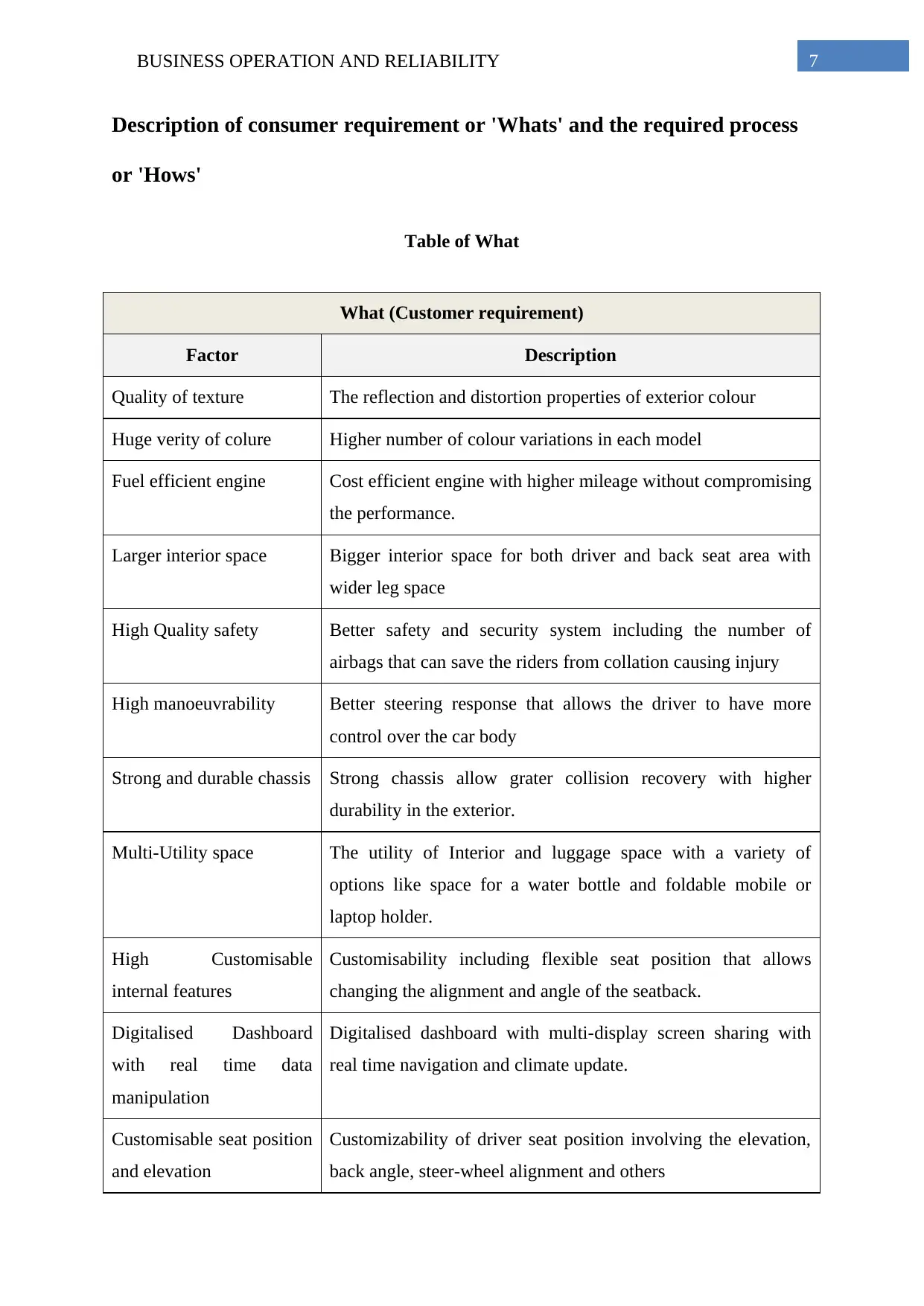
7BUSINESS OPERATION AND RELIABILITY
Description of consumer requirement or 'Whats' and the required process
or 'Hows'
Table of What
What (Customer requirement)
Factor Description
Quality of texture The reflection and distortion properties of exterior colour
Huge verity of colure Higher number of colour variations in each model
Fuel efficient engine Cost efficient engine with higher mileage without compromising
the performance.
Larger interior space Bigger interior space for both driver and back seat area with
wider leg space
High Quality safety Better safety and security system including the number of
airbags that can save the riders from collation causing injury
High manoeuvrability Better steering response that allows the driver to have more
control over the car body
Strong and durable chassis Strong chassis allow grater collision recovery with higher
durability in the exterior.
Multi-Utility space The utility of Interior and luggage space with a variety of
options like space for a water bottle and foldable mobile or
laptop holder.
High Customisable
internal features
Customisability including flexible seat position that allows
changing the alignment and angle of the seatback.
Digitalised Dashboard
with real time data
manipulation
Digitalised dashboard with multi-display screen sharing with
real time navigation and climate update.
Customisable seat position
and elevation
Customizability of driver seat position involving the elevation,
back angle, steer-wheel alignment and others
Description of consumer requirement or 'Whats' and the required process
or 'Hows'
Table of What
What (Customer requirement)
Factor Description
Quality of texture The reflection and distortion properties of exterior colour
Huge verity of colure Higher number of colour variations in each model
Fuel efficient engine Cost efficient engine with higher mileage without compromising
the performance.
Larger interior space Bigger interior space for both driver and back seat area with
wider leg space
High Quality safety Better safety and security system including the number of
airbags that can save the riders from collation causing injury
High manoeuvrability Better steering response that allows the driver to have more
control over the car body
Strong and durable chassis Strong chassis allow grater collision recovery with higher
durability in the exterior.
Multi-Utility space The utility of Interior and luggage space with a variety of
options like space for a water bottle and foldable mobile or
laptop holder.
High Customisable
internal features
Customisability including flexible seat position that allows
changing the alignment and angle of the seatback.
Digitalised Dashboard
with real time data
manipulation
Digitalised dashboard with multi-display screen sharing with
real time navigation and climate update.
Customisable seat position
and elevation
Customizability of driver seat position involving the elevation,
back angle, steer-wheel alignment and others
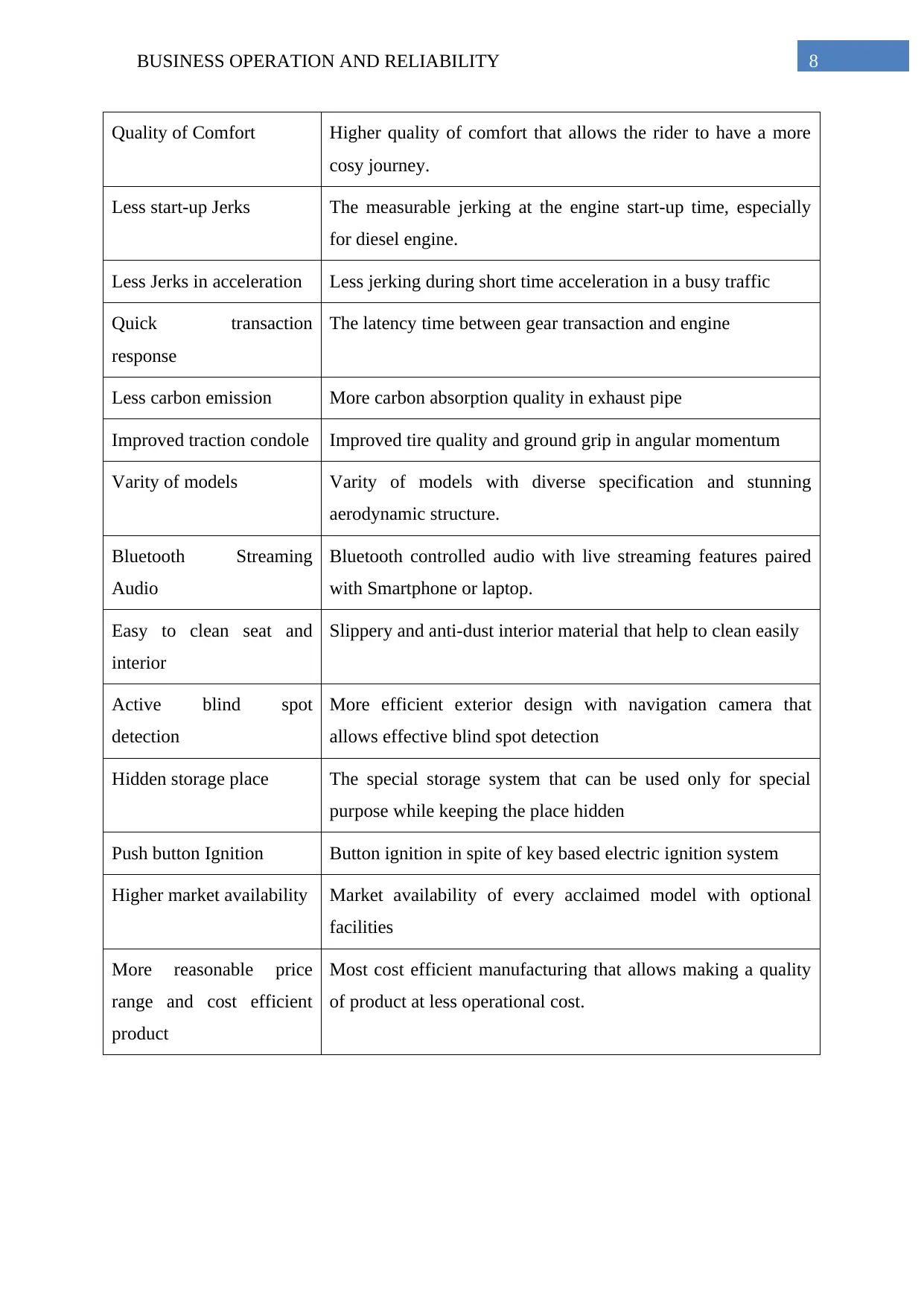
8BUSINESS OPERATION AND RELIABILITY
Quality of Comfort Higher quality of comfort that allows the rider to have a more
cosy journey.
Less start-up Jerks The measurable jerking at the engine start-up time, especially
for diesel engine.
Less Jerks in acceleration Less jerking during short time acceleration in a busy traffic
Quick transaction
response
The latency time between gear transaction and engine
Less carbon emission More carbon absorption quality in exhaust pipe
Improved traction condole Improved tire quality and ground grip in angular momentum
Varity of models Varity of models with diverse specification and stunning
aerodynamic structure.
Bluetooth Streaming
Audio
Bluetooth controlled audio with live streaming features paired
with Smartphone or laptop.
Easy to clean seat and
interior
Slippery and anti-dust interior material that help to clean easily
Active blind spot
detection
More efficient exterior design with navigation camera that
allows effective blind spot detection
Hidden storage place The special storage system that can be used only for special
purpose while keeping the place hidden
Push button Ignition Button ignition in spite of key based electric ignition system
Higher market availability Market availability of every acclaimed model with optional
facilities
More reasonable price
range and cost efficient
product
Most cost efficient manufacturing that allows making a quality
of product at less operational cost.
Quality of Comfort Higher quality of comfort that allows the rider to have a more
cosy journey.
Less start-up Jerks The measurable jerking at the engine start-up time, especially
for diesel engine.
Less Jerks in acceleration Less jerking during short time acceleration in a busy traffic
Quick transaction
response
The latency time between gear transaction and engine
Less carbon emission More carbon absorption quality in exhaust pipe
Improved traction condole Improved tire quality and ground grip in angular momentum
Varity of models Varity of models with diverse specification and stunning
aerodynamic structure.
Bluetooth Streaming
Audio
Bluetooth controlled audio with live streaming features paired
with Smartphone or laptop.
Easy to clean seat and
interior
Slippery and anti-dust interior material that help to clean easily
Active blind spot
detection
More efficient exterior design with navigation camera that
allows effective blind spot detection
Hidden storage place The special storage system that can be used only for special
purpose while keeping the place hidden
Push button Ignition Button ignition in spite of key based electric ignition system
Higher market availability Market availability of every acclaimed model with optional
facilities
More reasonable price
range and cost efficient
product
Most cost efficient manufacturing that allows making a quality
of product at less operational cost.
⊘ This is a preview!⊘
Do you want full access?
Subscribe today to unlock all pages.

Trusted by 1+ million students worldwide
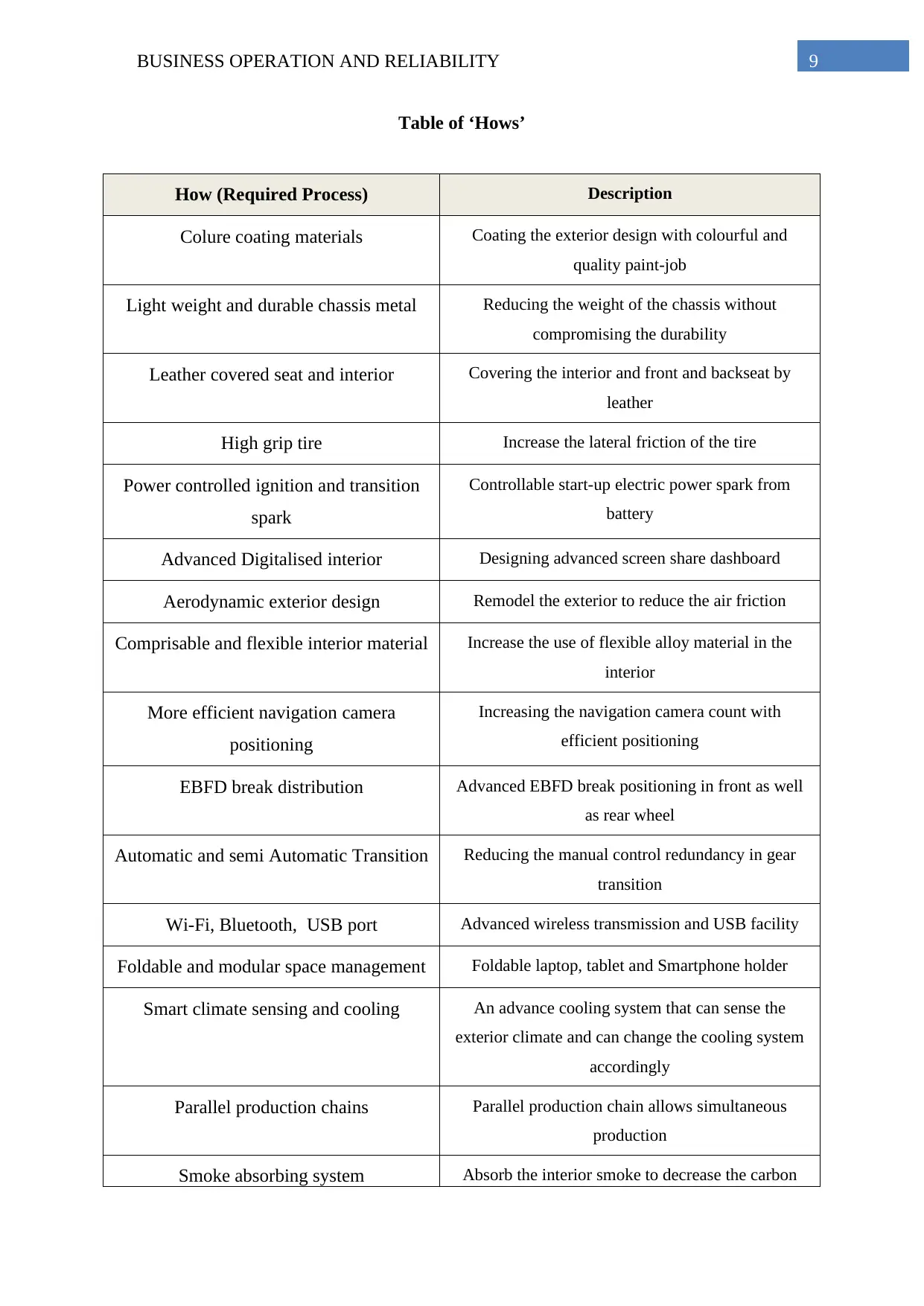
9BUSINESS OPERATION AND RELIABILITY
Table of ‘Hows’
How (Required Process) Description
Colure coating materials Coating the exterior design with colourful and
quality paint-job
Light weight and durable chassis metal Reducing the weight of the chassis without
compromising the durability
Leather covered seat and interior Covering the interior and front and backseat by
leather
High grip tire Increase the lateral friction of the tire
Power controlled ignition and transition
spark
Controllable start-up electric power spark from
battery
Advanced Digitalised interior Designing advanced screen share dashboard
Aerodynamic exterior design Remodel the exterior to reduce the air friction
Comprisable and flexible interior material Increase the use of flexible alloy material in the
interior
More efficient navigation camera
positioning
Increasing the navigation camera count with
efficient positioning
EBFD break distribution Advanced EBFD break positioning in front as well
as rear wheel
Automatic and semi Automatic Transition Reducing the manual control redundancy in gear
transition
Wi-Fi, Bluetooth, USB port Advanced wireless transmission and USB facility
Foldable and modular space management Foldable laptop, tablet and Smartphone holder
Smart climate sensing and cooling An advance cooling system that can sense the
exterior climate and can change the cooling system
accordingly
Parallel production chains Parallel production chain allows simultaneous
production
Smoke absorbing system Absorb the interior smoke to decrease the carbon
Table of ‘Hows’
How (Required Process) Description
Colure coating materials Coating the exterior design with colourful and
quality paint-job
Light weight and durable chassis metal Reducing the weight of the chassis without
compromising the durability
Leather covered seat and interior Covering the interior and front and backseat by
leather
High grip tire Increase the lateral friction of the tire
Power controlled ignition and transition
spark
Controllable start-up electric power spark from
battery
Advanced Digitalised interior Designing advanced screen share dashboard
Aerodynamic exterior design Remodel the exterior to reduce the air friction
Comprisable and flexible interior material Increase the use of flexible alloy material in the
interior
More efficient navigation camera
positioning
Increasing the navigation camera count with
efficient positioning
EBFD break distribution Advanced EBFD break positioning in front as well
as rear wheel
Automatic and semi Automatic Transition Reducing the manual control redundancy in gear
transition
Wi-Fi, Bluetooth, USB port Advanced wireless transmission and USB facility
Foldable and modular space management Foldable laptop, tablet and Smartphone holder
Smart climate sensing and cooling An advance cooling system that can sense the
exterior climate and can change the cooling system
accordingly
Parallel production chains Parallel production chain allows simultaneous
production
Smoke absorbing system Absorb the interior smoke to decrease the carbon
Paraphrase This Document
Need a fresh take? Get an instant paraphrase of this document with our AI Paraphraser
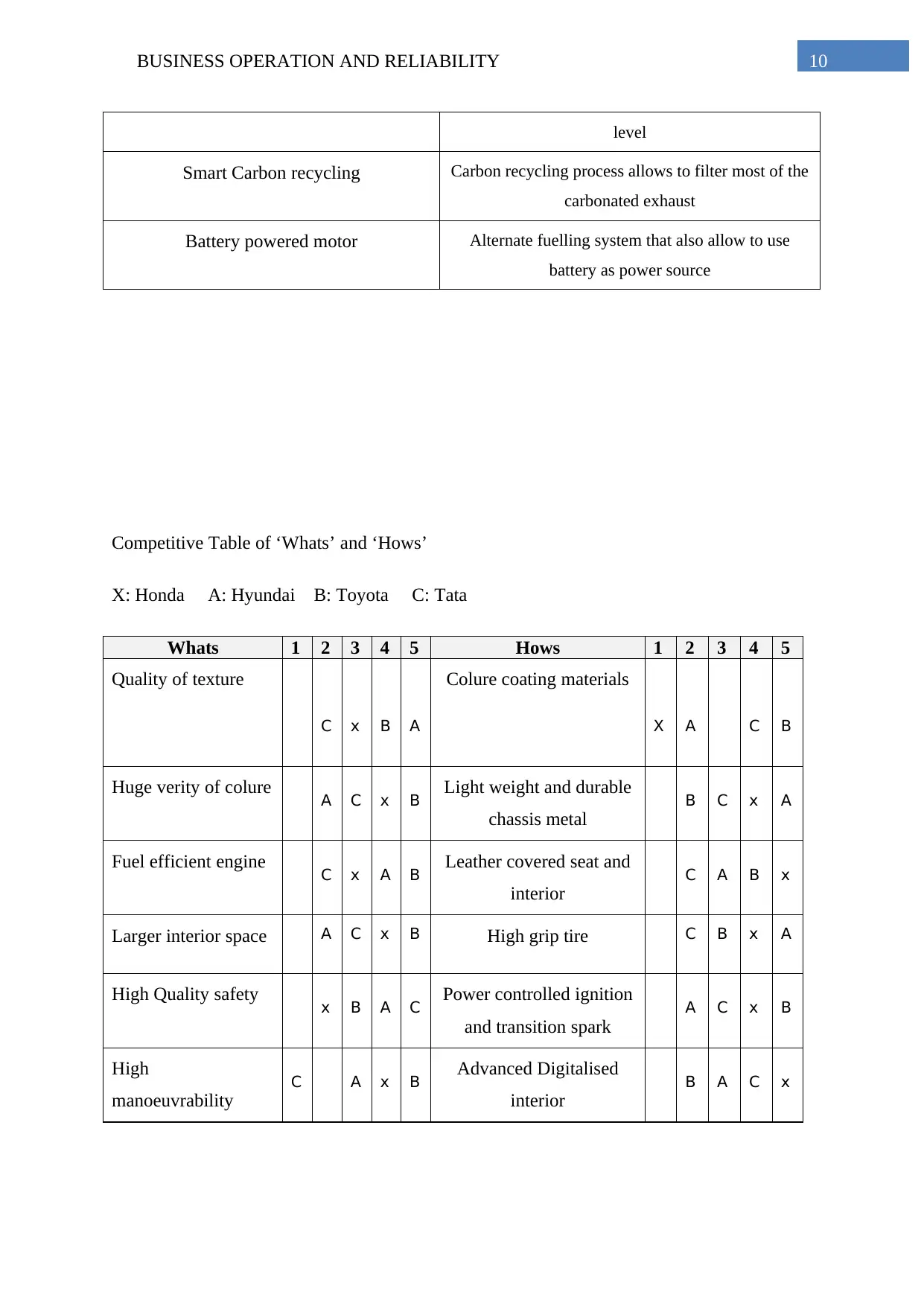
10BUSINESS OPERATION AND RELIABILITY
level
Smart Carbon recycling Carbon recycling process allows to filter most of the
carbonated exhaust
Battery powered motor Alternate fuelling system that also allow to use
battery as power source
Competitive Table of ‘Whats’ and ‘Hows’
X: Honda A: Hyundai B: Toyota C: Tata
Whats 1 2 3 4 5 Hows 1 2 3 4 5
Quality of texture
C x B A
Colure coating materials
X A C B
Huge verity of colure A C x B Light weight and durable
chassis metal
B C x A
Fuel efficient engine C x A B Leather covered seat and
interior
C A B x
Larger interior space A C x B High grip tire C B x A
High Quality safety x B A C Power controlled ignition
and transition spark
A C x B
High
manoeuvrability
C A x B Advanced Digitalised
interior
B A C x
level
Smart Carbon recycling Carbon recycling process allows to filter most of the
carbonated exhaust
Battery powered motor Alternate fuelling system that also allow to use
battery as power source
Competitive Table of ‘Whats’ and ‘Hows’
X: Honda A: Hyundai B: Toyota C: Tata
Whats 1 2 3 4 5 Hows 1 2 3 4 5
Quality of texture
C x B A
Colure coating materials
X A C B
Huge verity of colure A C x B Light weight and durable
chassis metal
B C x A
Fuel efficient engine C x A B Leather covered seat and
interior
C A B x
Larger interior space A C x B High grip tire C B x A
High Quality safety x B A C Power controlled ignition
and transition spark
A C x B
High
manoeuvrability
C A x B Advanced Digitalised
interior
B A C x
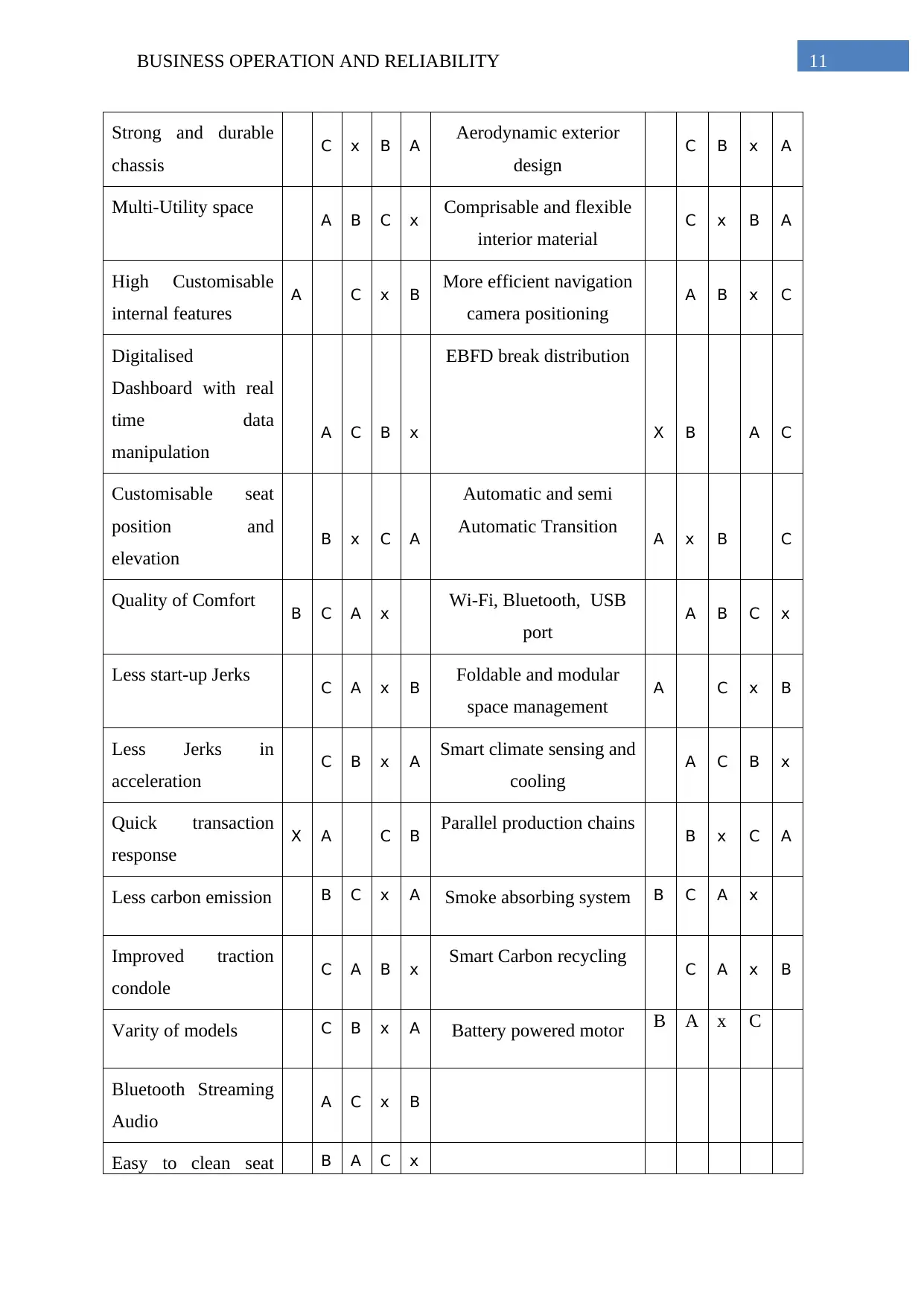
11BUSINESS OPERATION AND RELIABILITY
Strong and durable
chassis
C x B A Aerodynamic exterior
design
C B x A
Multi-Utility space A B C x Comprisable and flexible
interior material
C x B A
High Customisable
internal features
A C x B More efficient navigation
camera positioning
A B x C
Digitalised
Dashboard with real
time data
manipulation
A C B x
EBFD break distribution
X B A C
Customisable seat
position and
elevation
B x C A
Automatic and semi
Automatic Transition A x B C
Quality of Comfort B C A x Wi-Fi, Bluetooth, USB
port
A B C x
Less start-up Jerks C A x B Foldable and modular
space management
A C x B
Less Jerks in
acceleration
C B x A Smart climate sensing and
cooling
A C B x
Quick transaction
response
X A C B Parallel production chains B x C A
Less carbon emission B C x A Smoke absorbing system B C A x
Improved traction
condole
C A B x Smart Carbon recycling C A x B
Varity of models C B x A Battery powered motor B A x C
Bluetooth Streaming
Audio
A C x B
Easy to clean seat B A C x
Strong and durable
chassis
C x B A Aerodynamic exterior
design
C B x A
Multi-Utility space A B C x Comprisable and flexible
interior material
C x B A
High Customisable
internal features
A C x B More efficient navigation
camera positioning
A B x C
Digitalised
Dashboard with real
time data
manipulation
A C B x
EBFD break distribution
X B A C
Customisable seat
position and
elevation
B x C A
Automatic and semi
Automatic Transition A x B C
Quality of Comfort B C A x Wi-Fi, Bluetooth, USB
port
A B C x
Less start-up Jerks C A x B Foldable and modular
space management
A C x B
Less Jerks in
acceleration
C B x A Smart climate sensing and
cooling
A C B x
Quick transaction
response
X A C B Parallel production chains B x C A
Less carbon emission B C x A Smoke absorbing system B C A x
Improved traction
condole
C A B x Smart Carbon recycling C A x B
Varity of models C B x A Battery powered motor B A x C
Bluetooth Streaming
Audio
A C x B
Easy to clean seat B A C x
⊘ This is a preview!⊘
Do you want full access?
Subscribe today to unlock all pages.

Trusted by 1+ million students worldwide
1 out of 22
Related Documents
Your All-in-One AI-Powered Toolkit for Academic Success.
+13062052269
info@desklib.com
Available 24*7 on WhatsApp / Email
![[object Object]](/_next/static/media/star-bottom.7253800d.svg)
Unlock your academic potential
Copyright © 2020–2025 A2Z Services. All Rights Reserved. Developed and managed by ZUCOL.





